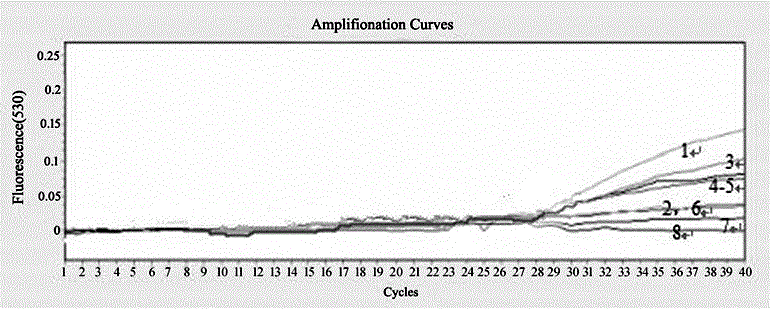Method for removing No.2 broad bean wilt virus in chili seeds
A technology for seeds and peppers, applied in the fields of seed and rhizome treatment, biochemical equipment and methods, and microbial measurement/inspection. There are no problems such as the evaluation of the detoxification effect of pepper seeds, and the effects of fast detection efficiency, shortened detection time, and improved germination potential have been achieved.
- Summary
- Abstract
- Description
- Claims
- Application Information
AI Technical Summary
Problems solved by technology
Method used
Image
Examples
Embodiment 1
[0036] Embodiment 1. The detoxification effect comparison of several detoxification methods
[0037] In this embodiment, seven detoxification methods are designed to detoxify pepper seeds, and non-detoxification pepper seeds are used as a control. The amount of seeds for each treatment is about 300 plump and poisonous pepper seeds. After seed detoxification treatment, BBWV2 in pepper seeds was quantitatively detected by TaqMan probe real-time fluorescent quantitative PCR detection method, and the detoxification effect of each detoxification method was compared.
[0038] 1. The detoxification method is designed as follows:
[0039] (1) Dry heat treatment method: Put the chili seeds to be detoxified in an oven, heat them with hot air for 48 hours at 70 ℃, and then let them stand to cool.
[0040] (2) Moist heat treatment method: Soak the chili seeds to be detoxified in 5 times the volume of boiling water, and quickly oscillate and cool to 40-45 ℃, filter the aqueous solution an...
Embodiment 2
[0063] Embodiment 2. The impact of several detoxification methods on pepper seed germination rate and germination potential
[0064] Randomly select 150 capsicum seeds of each detoxification treatment and non-detoxification treatment in Example 1, divide them into 3 groups, adopt the culture dish filter paper constant temperature germination method after soaking in cold water for 4 h, and germinate the seeds in a constant temperature incubator at 28°C. For the germination test, observe and count the germination situation day by day from the 3rd day after the treatment, record the number of germinations, measure the germination potential with the number of germinations of each detoxification treatment on the 7th day, and end the germination test on the 10th day. Germination rate (%) = (number of germinated seeds / number of tested seeds) × 100; germination potential (%) = (number of seeds germinated within a specified time / number of tested seeds) × 100.
[0065] The results o...
PUM
 Login to View More
Login to View More Abstract
Description
Claims
Application Information
 Login to View More
Login to View More - R&D
- Intellectual Property
- Life Sciences
- Materials
- Tech Scout
- Unparalleled Data Quality
- Higher Quality Content
- 60% Fewer Hallucinations
Browse by: Latest US Patents, China's latest patents, Technical Efficacy Thesaurus, Application Domain, Technology Topic, Popular Technical Reports.
© 2025 PatSnap. All rights reserved.Legal|Privacy policy|Modern Slavery Act Transparency Statement|Sitemap|About US| Contact US: help@patsnap.com



